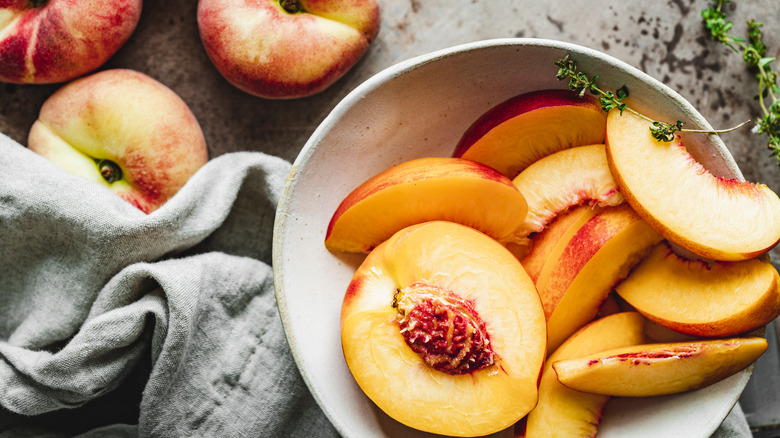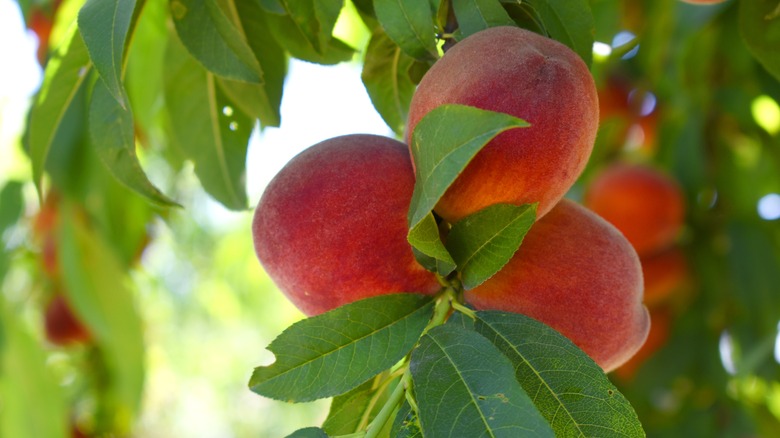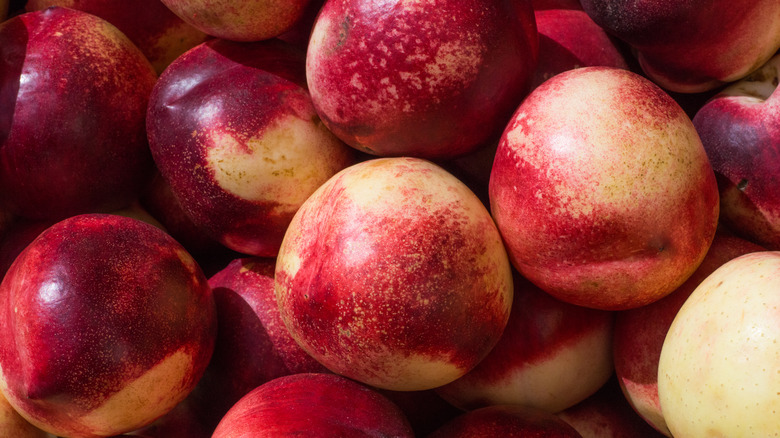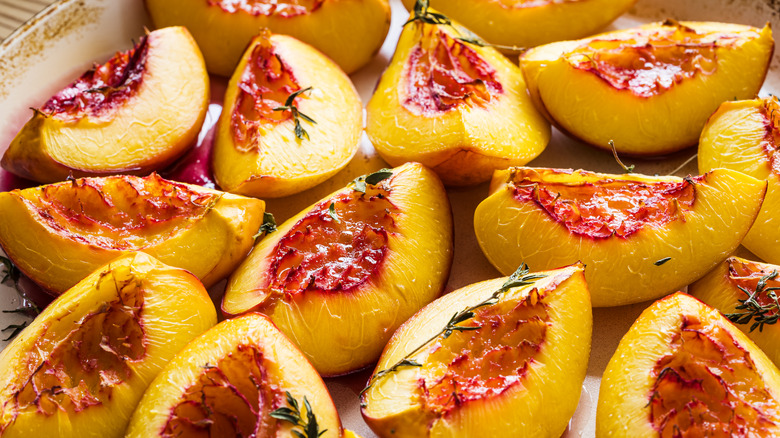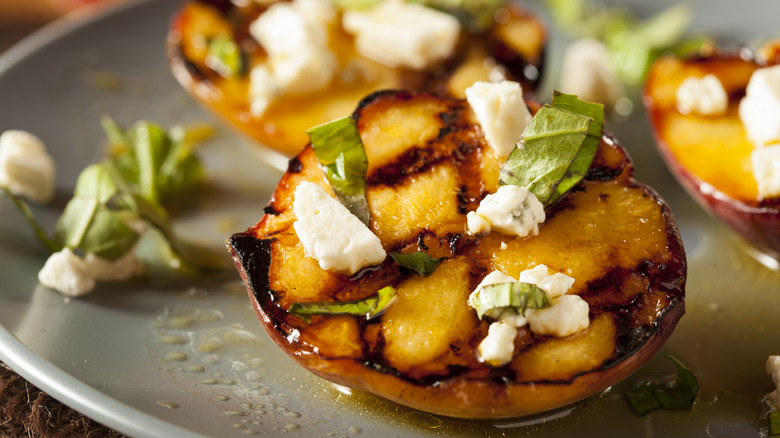Peaches Vs Nectarines: What's The Actual Difference?
Is any summer truly complete without an abundance of juicy, golden peaches and nectarines? Their acidic, lightly floral notes give them a more sophisticated flare than other summer fruits, making them ideal for an array of culinary applications. Juicy, sweet, and flavorful, both are a favorite seasonal ingredient in cobblers, crumbles, and crisps, cocktails, cakes, and even sweet and spicy salsas. However, there are key differences between these fruits that may make one more desirable than the other when indulging in warm-weather treats.
Though people often make a fuss about the fuzz, the differences between these two stone fruits are more than skin-deep. In addition to often being easier to find than nectarines, some people prefer peaches over nectarines because they're larger with a higher flesh-to-pit ratio. Of course, nectarines have a reputation for being juicier and more aromatic than their fuzzy cousins, meaning they may be a better choice for bellinis and syrups. Which one you choose will largely depend on availability and your personal preferences.
What are peaches?
Peaches are a stone fruit, meaning they have a large, hard pit in the center rather than multiple smaller seeds. Their trees produce delicate, sweet-scented, pink flowers early in the summer, with most trees producing fruit in July and August. They thrive best in zones 5 to 8 throughout California, Southern New Jersey, Georgia, and South Carolina. These areas experience distinct seasons without extreme temperature changes, which are the perfect conditions for growing peaches.
Though color and taste vary across varieties, most peaches feature juicy, tangy, yellow flesh perfect for making ice cream (even without a machine), caramelizing on the grill, or enjoying fresh right off the tree. There are also white peaches with lighter flesh and a slightly sweeter flavor, along with clingstone and freestone varieties. Clingstone peaches have flesh that adheres tightly to the central pit, while freestone means the pit will pull away easily from the fruit.
Of course, we can't talk about peaches without talking fuzz. Peaches are notorious for their fuzzy, red-and-gold skin. Though other hairy fruits exist — such as kiwi and raspberries — they usually feature coarse, rough exteriors. Peaches are among the only fruits with a soft, velvety skin that feels comforting in the hand, even if some find it less pleasant on the tongue.
What are nectarines?
Nectarines are actually a type of peach, meaning they're also a stone fruit that ripens on trees. However, nectarines express a recessive gene that gives them smooth, shiny skin rather than the velvety texture of a peach. As far as we can tell, nectarines developed alongside peaches naturally rather than as a result of selective pollination by human hands. In fact, nectarines and peaches have even been known to grow on the same tree, and growers have found patches of smooth and fuzzy skin on the same fruits.
Those who love peaches but hate the fuzz may prefer nectarines since their skin is fuzz-free and thinner. Some insist nectarines are also juicier and more fragrant, but these characteristics are so variable that it's hard to tell if this is universally true or not. The only verifiable advantage of nectarines over peaches is that nectarines are considered more pleasant to eat out of hand.
Nectarines are also one of many fruits that fall into the Rosaceae family, along with almonds, strawberries, cherries, pears, and more. This means people allergic to almonds may also be allergic to nectarines, and vice versa. However, if you're able to ingest them safely, nectarines may be a sweet and nutritious addition to your diet, as they're rich in vitamins A and C, magnesium, and potassium.
The naked truth about peaches vs. nectarines
The main difference between peaches and nectarines is, of course, the fuzz. Peaches have very small, fine, velvety hairs all over them, while nectarines are glossy. Nectarines also have thinner skin than peaches, making them easier to eat but harder to grow. Peach fuzz helps insulate the fruit against both extreme heat and cold, and helps prevent insects from snacking on them. A thicker skin also makes peaches less prone to bruising.
Without these defenses, nectarines ripen more slowly, bruise more easily, and are more prone to infestation and disease. These difficulties make nectarines less popular among fruit growers. In fact, nectarines only make up about 17% of peach production in the United States (remembering, of course, that nectarines are a type of peach).
Besides the presence or absence of fuzz, there are several more differences between these two fruits. Peaches tend to be large, soft, and sweet, while nectarines are usually smaller with firmer, more aromatic flesh — though there's some controversy about whether the difference in taste is consistent. The best way to compare their flavors for yourself is to choose ripe, high-quality peaches and nectarines from your grocery store or farmers market and conduct a taste test.
Sweet similarities between nectarines and peaches
As mentioned, peaches and nectarines are different versions of the same type of fruit. This means they're both part of the Rosaceae family, along with many other fruits and tree nuts. Additionally, both fruits come in clingstone and freestone varieties, and may be white or yellow. White peaches and nectarines often taste sweeter, while yellow versions of both fruits tend toward a tart, tangy flavor due to their higher acid content.
Both fruits also originated in China, and are still important to culinary and medicinal traditions there. Though many varieties of these fruits made their way throughout the ancient and medieval world, the ancestor of the soft, golden fruits we enjoy today wouldn't enter the U.S. until the mid-19th century. From there, peaches and nectarines proliferated throughout the more temperate areas of the United States.
Since all nectarines are peaches (but not all peaches are nectarines), it's also fairly easy to substitute one for the other in recipes. Nectarines tend to be smaller than peaches, so you may need to adjust the number of fruits you use, but both produce sweet, juicy baked goods and refreshing smoothies and salads. Just be sure to store your peaches and nectarines properly so they're fresh when you're ready to use them.
